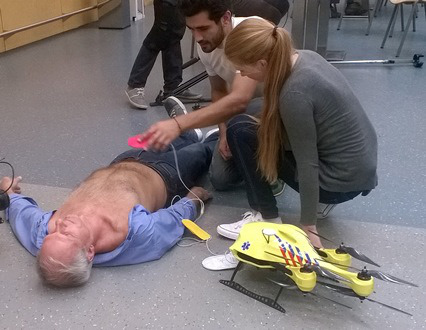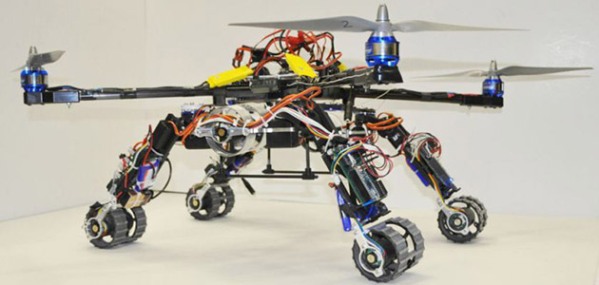Invitro tests octocopter for test delivery
The Invitro laboratory launched an octocopter with test tubes on board in Kabardino-Balkaria. Biomaterial overcame 12 kilometers in 15 minutes; in a car, this path along the roads would be 40 minutes.

The flight lasted 15 minutes. A special package with biomaterial was mounted on the drone, after which the drone transported it from the medical office in Chegem to the office in Nalchik. Specialists will track the movement of drones with “packages” from start to destination and study flight records.
The lab used DJI Spreading Wings S1000 +. The weight of the device is 4.4 kilograms, carrying capacity - up to 11 kilograms. The maximum speed is 90 km / h. The drone operates at temperatures from -10 ° C to + 40 ° C. Drone will help reduce the time of delivery of biomaterials and the timing of the analysis.
The flight was agreed with the Federal Air Transport Agency, all necessary permits were obtained.
All tubes for air transportation are barcoded. Data disclosure is not possible: patient personal data is stored in the system and is fully protected.

In Germany in 2013, they came up with the idea of dropping a defibrillator from a quadrocopter . The speed of the apparatus used was about 70 km / h; it could cover an area within a radius of 10 kilometers.
They tried to implement a similar idea in Europe in 2014. The developer of a drone with a defibrillator promised to increase the percentage of survival after heart failure in the European Union to increase to 80% from 8% - that is, to help save 640 thousand lives a year. The speed of the drone is about 100 km / h, weight 4 kg and load capacity 4 kg. Time plays a decisive role: as a rule, brain death occurs within 4-6 minutes after cardiac arrest. Defibrillation in the first minutes can save a life.

The HERALD quadrocopter carries with it two serpentine-like robots that can climb into the cracks to search for people under the rubble.

In the United States, for the first time in the country's history, in January 2015, a drone operator was fined $ 1,100 . The reason for this was a change in legislation that defined an unmanned airplane as an airplane. Now the US authorities are trying to legitimize the use of drones: NASA and Verizon are working on tracking the flight of civil and commercial drones in the country using radars, satellites and a cellular signal.
In Russia, fines started earlier: in October 2014, the West Siberian Transport Prosecutor's Office finedfor three thousand rubles a resident of Krasnoyarsk, who launched the DJI-phantom quadrocopter to a height of at least 25 meters in the area of residential development of the city. The basis - part 2 of article 11.4 of the Administrative Code of the Russian Federation "Violation of the rules for the use of airspace". In the same month, the creators of Copter Express were fined for delivering pizza to drones. The author of the idea was forced to abandon the project, and then the court decided to fine him for 50,000 rubles. The court found that in order to deliver pizza using drones, several permits had to be issued at once, including the use of airspace, a flight plan, and a license to transport goods on an aircraft. Later, the fine was canceled.
In the Air Code of the Russian Federation introduced an amendment to the UAV. Most likely, owners of drones with take-off weight (vehicle weight + maximum load capacity) of less than 30 kilograms will be freed from the need to register their devices in various instances, receive certificates of airworthiness and the right to fly.

The flight lasted 15 minutes. A special package with biomaterial was mounted on the drone, after which the drone transported it from the medical office in Chegem to the office in Nalchik. Specialists will track the movement of drones with “packages” from start to destination and study flight records.
The lab used DJI Spreading Wings S1000 +. The weight of the device is 4.4 kilograms, carrying capacity - up to 11 kilograms. The maximum speed is 90 km / h. The drone operates at temperatures from -10 ° C to + 40 ° C. Drone will help reduce the time of delivery of biomaterials and the timing of the analysis.
The flight was agreed with the Federal Air Transport Agency, all necessary permits were obtained.
All tubes for air transportation are barcoded. Data disclosure is not possible: patient personal data is stored in the system and is fully protected.

Medical Drones and Rescuers
In Germany in 2013, they came up with the idea of dropping a defibrillator from a quadrocopter . The speed of the apparatus used was about 70 km / h; it could cover an area within a radius of 10 kilometers.
They tried to implement a similar idea in Europe in 2014. The developer of a drone with a defibrillator promised to increase the percentage of survival after heart failure in the European Union to increase to 80% from 8% - that is, to help save 640 thousand lives a year. The speed of the drone is about 100 km / h, weight 4 kg and load capacity 4 kg. Time plays a decisive role: as a rule, brain death occurs within 4-6 minutes after cardiac arrest. Defibrillation in the first minutes can save a life.

The HERALD quadrocopter carries with it two serpentine-like robots that can climb into the cracks to search for people under the rubble.

Legislation
In the United States, for the first time in the country's history, in January 2015, a drone operator was fined $ 1,100 . The reason for this was a change in legislation that defined an unmanned airplane as an airplane. Now the US authorities are trying to legitimize the use of drones: NASA and Verizon are working on tracking the flight of civil and commercial drones in the country using radars, satellites and a cellular signal.
In Russia, fines started earlier: in October 2014, the West Siberian Transport Prosecutor's Office finedfor three thousand rubles a resident of Krasnoyarsk, who launched the DJI-phantom quadrocopter to a height of at least 25 meters in the area of residential development of the city. The basis - part 2 of article 11.4 of the Administrative Code of the Russian Federation "Violation of the rules for the use of airspace". In the same month, the creators of Copter Express were fined for delivering pizza to drones. The author of the idea was forced to abandon the project, and then the court decided to fine him for 50,000 rubles. The court found that in order to deliver pizza using drones, several permits had to be issued at once, including the use of airspace, a flight plan, and a license to transport goods on an aircraft. Later, the fine was canceled.
In the Air Code of the Russian Federation introduced an amendment to the UAV. Most likely, owners of drones with take-off weight (vehicle weight + maximum load capacity) of less than 30 kilograms will be freed from the need to register their devices in various instances, receive certificates of airworthiness and the right to fly.
